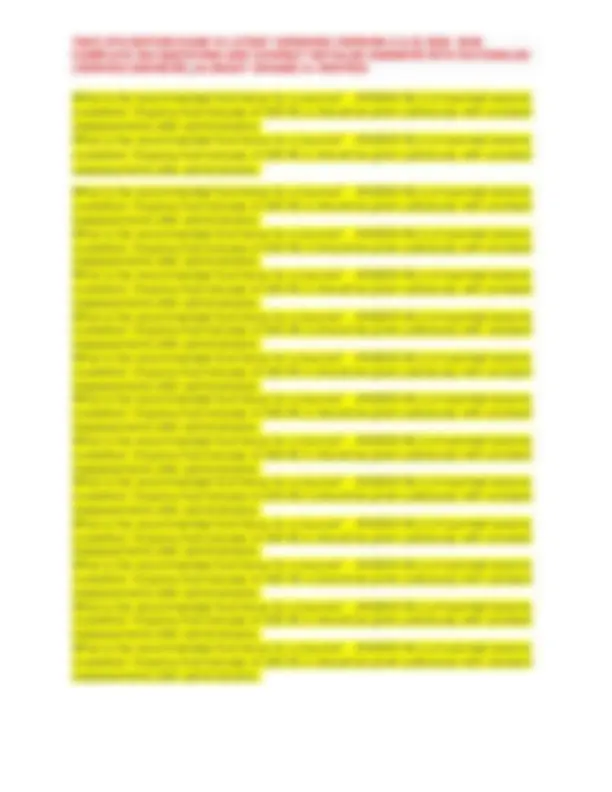






























































































Study with the several resources on Docsity

Earn points by helping other students or get them with a premium plan


Prepare for your exams
Study with the several resources on Docsity

Earn points to download
Earn points by helping other students or get them with a premium plan
Community
Ask the community for help and clear up your study doubts
Discover the best universities in your country according to Docsity users
Free resources
Download our free guides on studying techniques, anxiety management strategies, and thesis advice from Docsity tutors
TNCC 8TH EDITION EXAM 10 LATEST VERSIONS (VERSION A & B) 2025-2026 COMPLETE 300 QUESTIONS AND CORRECT DETAILED ANSWERS WITH RATIONALES (VERIFIED ANSWERS) ALREADY GRADED A+VERIFIED.pdf
Typology: Exams
1 / 378

This page cannot be seen from the preview
Don't miss anything!





























































































COMPLETE 300 QUESTIONS AND CORRECT DETAILED ANSWERS WITH RATIONALES (VERIFIED ANSWERS) |ALREADY GRADED A+VERIFIED You are treating a 27-year-old male in respiratory distress who was involved in a house fire. Calculating total body surface area (TBSA) burned is deferred due to the need for emergent intubation. At what rate should you begin fluid resuscitation? - ANS500 mL/hr You are caring for a patient who was involved in a motor vehicle crash and is 32 weeks pregnant. Findings of your secondary survey include abdominal pain on palpation, fundal height at the costal margin, and some dark bloody show. Varying accelerations and decelerations are noted on cardiotocography. These findings are most consistent with which of the following? - ANSPlacental abruption Why is a measure of serum lactate obtained in the initial assessment of a trauma patient? - ANSTo gauge end-organ perfusion and tissue hypoxia Which pulse pressure description is an indication of early hypovolemic shock? - ANSNarrow Which of the following values indicates the need for alcohol withdrawal interventions? - ANSCIWA-Ar of 36 Which of the following patients warrants referral to a burn center? - ANSA 52-year-old diabetic male with a partial-thickness burn to the left lower leg Which of the following occurs during the third impact of a motor vehicle crash? - ANSThe aorta is torn at its attachment with the ligamentum arteriosum Which of the following mnemonics can help the nurse prioritize care for a trauma patient with massive uncontrolled hemorrhage? - ANSMARCH Which of the following is true about the log-roll maneuver? - ANSIt can worsen cord damage from an unstable spinal injury Which of the following is NOT considered goal-directed therapy for cardiogenic shock? - ANSPericardiocentesis Which of the following is an expected finding in a patient with a tube thoracostomy connected to a chest drainage system? - ANSFluctuation in the water seal chamber Which of the following is a possible complication of positive-pressure ventilation? - ANSWorsening pneumothorax Which of the following is a late sign of increased intracranial pressure? - ANSDecreased respiratory effort Which of the following is a component of the trauma triad of death? - ANSAcidosis Which of the following injuries is LEAST likely to be promptly identified? - ANSBowel Which of the following considerations is most important when caring for a geriatric trauma patient? - ANSMedical history Which of the following assessment findings differentiates a tension pneumothorax from a simple pneumothorax? - ANSHypotension that worsens with inspiration (pulsus paradoxus) When would you use a nasopharyngeal airway versus an oral pharyngeal airway? - ANSNasopharyngeal airways is contraindicated in patients with facial trauma or a suspected basilar skull fracture. Oral pharyngeal airways is used in unresponsive patients unable to maintain their airway, without a gag reflex as a temporary measure to facilitate ventilation with a bag mask device or spontaneous ventilation until the patient can be intubated. According to newtons law which of these two force is greater: size or force? - ANSNeither. For each force there is an equal and opposite reaction.
COMPLETE 300 QUESTIONS AND CORRECT DETAILED ANSWERS WITH RATIONALES (VERIFIED ANSWERS) |ALREADY GRADED A+VERIFIED When would you use a nasopharyngeal airway versus an oral pharyngeal airway? - ANSNasopharyngeal airways is contraindicated in patients with facial trauma or a suspected basilar skull fracture. Oral pharyngeal airways is used in unresponsive patients unable to maintain their airway, without a gag reflex as a temporary measure to facilitate ventilation with a bag mask device or spontaneous ventilation until the patient can be intubated. According to newtons law which of these two force is greater: size or force? - ANSNeither. For each force there is an equal and opposite reaction. When would you use a nasopharyngeal airway versus an oral pharyngeal airway? - ANSNasopharyngeal airways is contraindicated in patients with facial trauma or a suspected basilar skull fracture. Oral pharyngeal airways is used in unresponsive patients unable to maintain their airway, without a gag reflex as a temporary measure to facilitate ventilation with a bag mask device or spontaneous ventilation until the patient can be intubated. According to newtons law which of these two force is greater: size or force? - ANSNeither. For each force there is an equal and opposite reaction. When would you use a nasopharyngeal airway versus an oral pharyngeal airway? - ANSNasopharyngeal airways is contraindicated in patients with facial trauma or a suspected basilar skull fracture. Oral pharyngeal airways is used in unresponsive patients unable to maintain their airway, without a gag reflex as a temporary measure to facilitate ventilation with a bag mask device or spontaneous ventilation until the patient can be intubated. According to newtons law which of these two force is greater: size or force? - ANSNeither. For each force there is an equal and opposite reaction. When would you use a nasopharyngeal airway versus an oral pharyngeal airway? - ANSNasopharyngeal airways is contraindicated in patients with facial trauma or a suspected basilar skull fracture. Oral pharyngeal airways is used in unresponsive patients unable to maintain their airway, without a gag reflex as a temporary measure to facilitate ventilation with a bag mask device or spontaneous ventilation until the patient can be intubated. According to newtons law which of these two force is greater: size or force? - ANSNeither. For each force there is an equal and opposite reaction. When would you use a nasopharyngeal airway versus an oral pharyngeal airway? - ANSNasopharyngeal airways is contraindicated in patients with facial trauma or a suspected basilar skull fracture. Oral pharyngeal airways is used in unresponsive patients unable to maintain their airway, without a gag reflex as a temporary measure to facilitate ventilation with a bag mask device or spontaneous ventilation until the patient can be intubated. According to newtons law which of these two force is greater: size or force? - ANSNeither. For each force there is an equal and opposite reaction. When would you use a nasopharyngeal airway versus an oral pharyngeal airway? - ANSNasopharyngeal airways is contraindicated in patients with facial trauma or a suspected basilar skull fracture. Oral pharyngeal airways is used in unresponsive patients unable to maintain their airway, without a gag reflex as a temporary measure to
COMPLETE 300 QUESTIONS AND CORRECT DETAILED ANSWERS WITH RATIONALES (VERIFIED ANSWERS) |ALREADY GRADED A+VERIFIED When would you use a nasopharyngeal airway versus an oral pharyngeal airway? - ANSNasopharyngeal airways is contraindicated in patients with facial trauma or a suspected basilar skull fracture. Oral pharyngeal airways is used in unresponsive patients unable to maintain their airway, without a gag reflex as a temporary measure to facilitate ventilation with a bag mask device or spontaneous ventilation until the patient can be intubated. According to newtons law which of these two force is greater: size or force? - ANSNeither. For each force there is an equal and opposite reaction. When would you use a nasopharyngeal airway versus an oral pharyngeal airway? - ANSNasopharyngeal airways is contraindicated in patients with facial trauma or a suspected basilar skull fracture. Oral pharyngeal airways is used in unresponsive patients unable to maintain their airway, without a gag reflex as a temporary measure to facilitate ventilation with a bag mask device or spontaneous ventilation until the patient can be intubated. According to newtons law which of these two force is greater: size or force? - ANSNeither. For each force there is an equal and opposite reaction. When would you use a nasopharyngeal airway versus an oral pharyngeal airway? - ANSNasopharyngeal airways is contraindicated in patients with facial trauma or a suspected basilar skull fracture. Oral pharyngeal airways is used in unresponsive patients unable to maintain their airway, without a gag reflex as a temporary measure to facilitate ventilation with a bag mask device or spontaneous ventilation until the patient can be intubated. According to newtons law which of these two force is greater: size or force? - ANSNeither. For each force there is an equal and opposite reaction. When would you use a nasopharyngeal airway versus an oral pharyngeal airway? - ANSNasopharyngeal airways is contraindicated in patients with facial trauma or a suspected basilar skull fracture. Oral pharyngeal airways is used in unresponsive patients unable to maintain their airway, without a gag reflex as a temporary measure to facilitate ventilation with a bag mask device or spontaneous ventilation until the patient can be intubated. According to newtons law which of these two force is greater: size or force? - ANSNeither. For each force there is an equal and opposite reaction. When would you use a nasopharyngeal airway versus an oral pharyngeal airway? - ANSNasopharyngeal airways is contraindicated in patients with facial trauma or a suspected basilar skull fracture. Oral pharyngeal airways is used in unresponsive patients unable to maintain their airway, without a gag reflex as a temporary measure to facilitate ventilation with a bag mask device or spontaneous ventilation until the patient can be intubated. According to newtons law which of these two force is greater: size or force? - ANSNeither. For each force there is an equal and opposite reaction. When would you use a nasopharyngeal airway versus an oral pharyngeal airway? - ANSNasopharyngeal airways is contraindicated in patients with facial trauma or a suspected basilar skull fracture. Oral pharyngeal airways is used in unresponsive patients unable to maintain their airway, without a gag reflex as a temporary measure to
COMPLETE 300 QUESTIONS AND CORRECT DETAILED ANSWERS WITH RATIONALES (VERIFIED ANSWERS) |ALREADY GRADED A+VERIFIED facilitate ventilation with a bag mask device or spontaneous ventilation until the patient can be intubated. According to newtons law which of these two force is greater: size or force? - ANSNeither. For each force there is an equal and opposite reaction. When would you use a nasopharyngeal airway versus an oral pharyngeal airway? - ANSNasopharyngeal airways is contraindicated in patients with facial trauma or a suspected basilar skull fracture. Oral pharyngeal airways is used in unresponsive patients unable to maintain their airway, without a gag reflex as a temporary measure to facilitate ventilation with a bag mask device or spontaneous ventilation until the patient can be intubated. According to newtons law which of these two force is greater: size or force? - ANSNeither. For each force there is an equal and opposite reaction. When would you use a nasopharyngeal airway versus an oral pharyngeal airway? - ANSNasopharyngeal airways is contraindicated in patients with facial trauma or a suspected basilar skull fracture. Oral pharyngeal airways is used in unresponsive patients unable to maintain their airway, without a gag reflex as a temporary measure to facilitate ventilation with a bag mask device or spontaneous ventilation until the patient can be intubated. According to newtons law which of these two force is greater: size or force? - ANSNeither. For each force there is an equal and opposite reaction. When would you use a nasopharyngeal airway versus an oral pharyngeal airway? - ANSNasopharyngeal airways is contraindicated in patients with facial trauma or a suspected basilar skull fracture. Oral pharyngeal airways is used in unresponsive patients unable to maintain their airway, without a gag reflex as a temporary measure to facilitate ventilation with a bag mask device or spontaneous ventilation until the patient can be intubated. According to newtons law which of these two force is greater: size or force? - ANSNeither. For each force there is an equal and opposite reaction. When would you use a nasopharyngeal airway versus an oral pharyngeal airway? - ANSNasopharyngeal airways is contraindicated in patients with facial trauma or a suspected basilar skull fracture. Oral pharyngeal airways is used in unresponsive patients unable to maintain their airway, without a gag reflex as a temporary measure to facilitate ventilation with a bag mask device or spontaneous ventilation until the patient can be intubated. According to newtons law which of these two force is greater: size or force? - ANSNeither. For each force there is an equal and opposite reaction. When would you use a nasopharyngeal airway versus an oral pharyngeal airway? - ANSNasopharyngeal airways is contraindicated in patients with facial trauma or a suspected basilar skull fracture. Oral pharyngeal airways is used in unresponsive patients unable to maintain their airway, without a gag reflex as a temporary measure to facilitate ventilation with a bag mask device or spontaneous ventilation until the patient can be intubated. According to newtons law which of these two force is greater: size or force? - ANSNeither. For each force there is an equal and opposite reaction.
COMPLETE 300 QUESTIONS AND CORRECT DETAILED ANSWERS WITH RATIONALES (VERIFIED ANSWERS) |ALREADY GRADED A+VERIFIED facilitate ventilation with a bag mask device or spontaneous ventilation until the patient can be intubated. According to newtons law which of these two force is greater: size or force? - ANSNeither. For each force there is an equal and opposite reaction. When would you use a nasopharyngeal airway versus an oral pharyngeal airway? - ANSNasopharyngeal airways is contraindicated in patients with facial trauma or a suspected basilar skull fracture. Oral pharyngeal airways is used in unresponsive patients unable to maintain their airway, without a gag reflex as a temporary measure to facilitate ventilation with a bag mask device or spontaneous ventilation until the patient can be intubated. According to newtons law which of these two force is greater: size or force? - ANSNeither. For each force there is an equal and opposite reaction. When would you use a nasopharyngeal airway versus an oral pharyngeal airway? - ANSNasopharyngeal airways is contraindicated in patients with facial trauma or a suspected basilar skull fracture. Oral pharyngeal airways is used in unresponsive patients unable to maintain their airway, without a gag reflex as a temporary measure to facilitate ventilation with a bag mask device or spontaneous ventilation until the patient can be intubated. According to newtons law which of these two force is greater: size or force? - ANSNeither. For each force there is an equal and opposite reaction. When would you use a nasopharyngeal airway versus an oral pharyngeal airway? - ANSNasopharyngeal airways is contraindicated in patients with facial trauma or a suspected basilar skull fracture. Oral pharyngeal airways is used in unresponsive patients unable to maintain their airway, without a gag reflex as a temporary measure to facilitate ventilation with a bag mask device or spontaneous ventilation until the patient can be intubated. According to newtons law which of these two force is greater: size or force? - ANSNeither. For each force there is an equal and opposite reaction. When would you use a nasopharyngeal airway versus an oral pharyngeal airway? - ANSNasopharyngeal airways is contraindicated in patients with facial trauma or a suspected basilar skull fracture. Oral pharyngeal airways is used in unresponsive patients unable to maintain their airway, without a gag reflex as a temporary measure to facilitate ventilation with a bag mask device or spontaneous ventilation until the patient can be intubated. According to newtons law which of these two force is greater: size or force? - ANSNeither. For each force there is an equal and opposite reaction. When would you use a nasopharyngeal airway versus an oral pharyngeal airway? - ANSNasopharyngeal airways is contraindicated in patients with facial trauma or a suspected basilar skull fracture. Oral pharyngeal airways is used in unresponsive patients unable to maintain their airway, without a gag reflex as a temporary measure to facilitate ventilation with a bag mask device or spontaneous ventilation until the patient can be intubated. According to newtons law which of these two force is greater: size or force? - ANSNeither. For each force there is an equal and opposite reaction.
COMPLETE 300 QUESTIONS AND CORRECT DETAILED ANSWERS WITH RATIONALES (VERIFIED ANSWERS) |ALREADY GRADED A+VERIFIED When would you use a nasopharyngeal airway versus an oral pharyngeal airway? - ANSNasopharyngeal airways is contraindicated in patients with facial trauma or a suspected basilar skull fracture. Oral pharyngeal airways is used in unresponsive patients unable to maintain their airway, without a gag reflex as a temporary measure to facilitate ventilation with a bag mask device or spontaneous ventilation until the patient can be intubated. According to newtons law which of these two force is greater: size or force? - ANSNeither. For each force there is an equal and opposite reaction. When would you use a nasopharyngeal airway versus an oral pharyngeal airway? - ANSNasopharyngeal airways is contraindicated in patients with facial trauma or a suspected basilar skull fracture. Oral pharyngeal airways is used in unresponsive patients unable to maintain their airway, without a gag reflex as a temporary measure to facilitate ventilation with a bag mask device or spontaneous ventilation until the patient can be intubated. According to newtons law which of these two force is greater: size or force? - ANSNeither. For each force there is an equal and opposite reaction. When would you use a nasopharyngeal airway versus an oral pharyngeal airway? - ANSNasopharyngeal airways is contraindicated in patients with facial trauma or a suspected basilar skull fracture. Oral pharyngeal airways is used in unresponsive patients unable to maintain their airway, without a gag reflex as a temporary measure to facilitate ventilation with a bag mask device or spontaneous ventilation until the patient can be intubated. According to newtons law which of these two force is greater: size or force? - ANSNeither. For each force there is an equal and opposite reaction. When would you use a nasopharyngeal airway versus an oral pharyngeal airway? - ANSNasopharyngeal airways is contraindicated in patients with facial trauma or a suspected basilar skull fracture. Oral pharyngeal airways is used in unresponsive patients unable to maintain their airway, without a gag reflex as a temporary measure to facilitate ventilation with a bag mask device or spontaneous ventilation until the patient can be intubated. According to newtons law which of these two force is greater: size or force? - ANSNeither. For each force there is an equal and opposite reaction. When would you use a nasopharyngeal airway versus an oral pharyngeal airway? - ANSNasopharyngeal airways is contraindicated in patients with facial trauma or a suspected basilar skull fracture. Oral pharyngeal airways is used in unresponsive patients unable to maintain their airway, without a gag reflex as a temporary measure to facilitate ventilation with a bag mask device or spontaneous ventilation until the patient can be intubated. According to newtons law which of these two force is greater: size or force? - ANSNeither. For each force there is an equal and opposite reaction. When would you use a nasopharyngeal airway versus an oral pharyngeal airway? - ANSNasopharyngeal airways is contraindicated in patients with facial trauma or a suspected basilar skull fracture. Oral pharyngeal airways is used in unresponsive patients unable to maintain their airway, without a gag reflex as a temporary measure to
COMPLETE 300 QUESTIONS AND CORRECT DETAILED ANSWERS WITH RATIONALES (VERIFIED ANSWERS) |ALREADY GRADED A+VERIFIED When would you use a nasopharyngeal airway versus an oral pharyngeal airway? - ANSNasopharyngeal airways is contraindicated in patients with facial trauma or a suspected basilar skull fracture. Oral pharyngeal airways is used in unresponsive patients unable to maintain their airway, without a gag reflex as a temporary measure to facilitate ventilation with a bag mask device or spontaneous ventilation until the patient can be intubated. According to newtons law which of these two force is greater: size or force? - ANSNeither. For each force there is an equal and opposite reaction. When would you use a nasopharyngeal airway versus an oral pharyngeal airway? - ANSNasopharyngeal airways is contraindicated in patients with facial trauma or a suspected basilar skull fracture. Oral pharyngeal airways is used in unresponsive patients unable to maintain their airway, without a gag reflex as a temporary measure to facilitate ventilation with a bag mask device or spontaneous ventilation until the patient can be intubated. According to newtons law which of these two force is greater: size or force? - ANSNeither. For each force there is an equal and opposite reaction. When would you use a nasopharyngeal airway versus an oral pharyngeal airway? - ANSNasopharyngeal airways is contraindicated in patients with facial trauma or a suspected basilar skull fracture. Oral pharyngeal airways is used in unresponsive patients unable to maintain their airway, without a gag reflex as a temporary measure to facilitate ventilation with a bag mask device or spontaneous ventilation until the patient can be intubated. According to newtons law which of these two force is greater: size or force? - ANSNeither. For each force there is an equal and opposite reaction. When would you use a nasopharyngeal airway versus an oral pharyngeal airway? - ANSNasopharyngeal airways is contraindicated in patients with facial trauma or a suspected basilar skull fracture. Oral pharyngeal airways is used in unresponsive patients unable to maintain their airway, without a gag reflex as a temporary measure to facilitate ventilation with a bag mask device or spontaneous ventilation until the patient can be intubated. According to newtons law which of these two force is greater: size or force? - ANSNeither. For each force there is an equal and opposite reaction. When would you use a nasopharyngeal airway versus an oral pharyngeal airway? - ANSNasopharyngeal airways is contraindicated in patients with facial trauma or a suspected basilar skull fracture. Oral pharyngeal airways is used in unresponsive patients unable to maintain their airway, without a gag reflex as a temporary measure to facilitate ventilation with a bag mask device or spontaneous ventilation until the patient can be intubated. According to newtons law which of these two force is greater: size or force? - ANSNeither. For each force there is an equal and opposite reaction. When would you use a nasopharyngeal airway versus an oral pharyngeal airway? - ANSNasopharyngeal airways is contraindicated in patients with facial trauma or a suspected basilar skull fracture. Oral pharyngeal airways is used in unresponsive patients unable to maintain their airway, without a gag reflex as a temporary measure to
COMPLETE 300 QUESTIONS AND CORRECT DETAILED ANSWERS WITH RATIONALES (VERIFIED ANSWERS) |ALREADY GRADED A+VERIFIED facilitate ventilation with a bag mask device or spontaneous ventilation until the patient can be intubated. According to newtons law which of these two force is greater: size or force? - ANSNeither. For each force there is an equal and opposite reaction. When would you use a nasopharyngeal airway versus an oral pharyngeal airway? - ANSNasopharyngeal airways is contraindicated in patients with facial trauma or a suspected basilar skull fracture. Oral pharyngeal airways is used in unresponsive patients unable to maintain their airway, without a gag reflex as a temporary measure to facilitate ventilation with a bag mask device or spontaneous ventilation until the patient can be intubated. According to newtons law which of these two force is greater: size or force? - ANSNeither. For each force there is an equal and opposite reaction. When would you use a nasopharyngeal airway versus an oral pharyngeal airway? - ANSNasopharyngeal airways is contraindicated in patients with facial trauma or a suspected basilar skull fracture. Oral pharyngeal airways is used in unresponsive patients unable to maintain their airway, without a gag reflex as a temporary measure to facilitate ventilation with a bag mask device or spontaneous ventilation until the patient can be intubated. According to newtons law which of these two force is greater: size or force? - ANSNeither. For each force there is an equal and opposite reaction. When would you use a nasopharyngeal airway versus an oral pharyngeal airway? - ANSNasopharyngeal airways is contraindicated in patients with facial trauma or a suspected basilar skull fracture. Oral pharyngeal airways is used in unresponsive patients unable to maintain their airway, without a gag reflex as a temporary measure to facilitate ventilation with a bag mask device or spontaneous ventilation until the patient can be intubated. According to newtons law which of these two force is greater: size or force? - ANSNeither. For each force there is an equal and opposite reaction. When would you use a nasopharyngeal airway versus an oral pharyngeal airway? - ANSNasopharyngeal airways is contraindicated in patients with facial trauma or a suspected basilar skull fracture. Oral pharyngeal airways is used in unresponsive patients unable to maintain their airway, without a gag reflex as a temporary measure to facilitate ventilation with a bag mask device or spontaneous ventilation until the patient can be intubated. According to newtons law which of these two force is greater: size or force? - ANSNeither. For each force there is an equal and opposite reaction. When would you use a nasopharyngeal airway versus an oral pharyngeal airway? - ANSNasopharyngeal airways is contraindicated in patients with facial trauma or a suspected basilar skull fracture. Oral pharyngeal airways is used in unresponsive patients unable to maintain their airway, without a gag reflex as a temporary measure to facilitate ventilation with a bag mask device or spontaneous ventilation until the patient can be intubated. According to newtons law which of these two force is greater: size or force? - ANSNeither. For each force there is an equal and opposite reaction.
COMPLETE 300 QUESTIONS AND CORRECT DETAILED ANSWERS WITH RATIONALES (VERIFIED ANSWERS) |ALREADY GRADED A+VERIFIED facilitate ventilation with a bag mask device or spontaneous ventilation until the patient can be intubated. According to newtons law which of these two force is greater: size or force? - ANSNeither. For each force there is an equal and opposite reaction. When would you use a nasopharyngeal airway versus an oral pharyngeal airway? - ANSNasopharyngeal airways is contraindicated in patients with facial trauma or a suspected basilar skull fracture. Oral pharyngeal airways is used in unresponsive patients unable to maintain their airway, without a gag reflex as a temporary measure to facilitate ventilation with a bag mask device or spontaneous ventilation until the patient can be intubated. According to newtons law which of these two force is greater: size or force? - ANSNeither. For each force there is an equal and opposite reaction. When would you use a nasopharyngeal airway versus an oral pharyngeal airway? - ANSNasopharyngeal airways is contraindicated in patients with facial trauma or a suspected basilar skull fracture. Oral pharyngeal airways is used in unresponsive patients unable to maintain their airway, without a gag reflex as a temporary measure to facilitate ventilation with a bag mask device or spontaneous ventilation until the patient can be intubated. According to newtons law which of these two force is greater: size or force? - ANSNeither. For each force there is an equal and opposite reaction. When would you use a nasopharyngeal airway versus an oral pharyngeal airway? - ANSNasopharyngeal airways is contraindicated in patients with facial trauma or a suspected basilar skull fracture. Oral pharyngeal airways is used in unresponsive patients unable to maintain their airway, without a gag reflex as a temporary measure to facilitate ventilation with a bag mask device or spontaneous ventilation until the patient can be intubated. According to newtons law which of these two force is greater: size or force? - ANSNeither. For each force there is an equal and opposite reaction. When would you use a nasopharyngeal airway versus an oral pharyngeal airway? - ANSNasopharyngeal airways is contraindicated in patients with facial trauma or a suspected basilar skull fracture. Oral pharyngeal airways is used in unresponsive patients unable to maintain their airway, without a gag reflex as a temporary measure to facilitate ventilation with a bag mask device or spontaneous ventilation until the patient can be intubated. According to newtons law which of these two force is greater: size or force? - ANSNeither. For each force there is an equal and opposite reaction. When would you use a nasopharyngeal airway versus an oral pharyngeal airway? - ANSNasopharyngeal airways is contraindicated in patients with facial trauma or a suspected basilar skull fracture. Oral pharyngeal airways is used in unresponsive patients unable to maintain their airway, without a gag reflex as a temporary measure to facilitate ventilation with a bag mask device or spontaneous ventilation until the patient can be intubated. According to newtons law which of these two force is greater: size or force? - ANSNeither. For each force there is an equal and opposite reaction.
COMPLETE 300 QUESTIONS AND CORRECT DETAILED ANSWERS WITH RATIONALES (VERIFIED ANSWERS) |ALREADY GRADED A+VERIFIED When would you use a nasopharyngeal airway versus an oral pharyngeal airway? - ANSNasopharyngeal airways is contraindicated in patients with facial trauma or a suspected basilar skull fracture. Oral pharyngeal airways is used in unresponsive patients unable to maintain their airway, without a gag reflex as a temporary measure to facilitate ventilation with a bag mask device or spontaneous ventilation until the patient can be intubated. According to newtons law which of these two force is greater: size or force? - ANSNeither. For each force there is an equal and opposite reaction. When would you use a nasopharyngeal airway versus an oral pharyngeal airway? - ANSNasopharyngeal airways is contraindicated in patients with facial trauma or a suspected basilar skull fracture. Oral pharyngeal airways is used in unresponsive patients unable to maintain their airway, without a gag reflex as a temporary measure to facilitate ventilation with a bag mask device or spontaneous ventilation until the patient can be intubated. According to newtons law which of these two force is greater: size or force? - ANSNeither. For each force there is an equal and opposite reaction. When would you use a nasopharyngeal airway versus an oral pharyngeal airway? - ANSNasopharyngeal airways is contraindicated in patients with facial trauma or a suspected basilar skull fracture. Oral pharyngeal airways is used in unresponsive patients unable to maintain their airway, without a gag reflex as a temporary measure to facilitate ventilation with a bag mask device or spontaneous ventilation until the patient can be intubated. According to newtons law which of these two force is greater: size or force? - ANSNeither. For each force there is an equal and opposite reaction. When would you use a nasopharyngeal airway versus an oral pharyngeal airway? - ANSNasopharyngeal airways is contraindicated in patients with facial trauma or a suspected basilar skull fracture. Oral pharyngeal airways is used in unresponsive patients unable to maintain their airway, without a gag reflex as a temporary measure to facilitate ventilation with a bag mask device or spontaneous ventilation until the patient can be intubated. According to newtons law which of these two force is greater: size or force? - ANSNeither. For each force there is an equal and opposite reaction. When would you use a nasopharyngeal airway versus an oral pharyngeal airway? - ANSNasopharyngeal airways is contraindicated in patients with facial trauma or a suspected basilar skull fracture. Oral pharyngeal airways is used in unresponsive patients unable to maintain their airway, without a gag reflex as a temporary measure to facilitate ventilation with a bag mask device or spontaneous ventilation until the patient can be intubated. According to newtons law which of these two force is greater: size or force? - ANSNeither. For each force there is an equal and opposite reaction. When would you use a nasopharyngeal airway versus an oral pharyngeal airway? - ANSNasopharyngeal airways is contraindicated in patients with facial trauma or a suspected basilar skull fracture. Oral pharyngeal airways is used in unresponsive patients unable to maintain their airway, without a gag reflex as a temporary measure to
COMPLETE 300 QUESTIONS AND CORRECT DETAILED ANSWERS WITH RATIONALES (VERIFIED ANSWERS) |ALREADY GRADED A+VERIFIED When capnography measurement reads less than 35MMHG, the nurse should consider increasing or decreasing the ventilation rate? - ANSDecreasing the ventilation rate. By doing so, the nurse allows the patient to retain CO2. When capnography measurement reads less than 35MMHG, the nurse should consider increasing or decreasing the ventilation rate? - ANSDecreasing the ventilation rate. By doing so, the nurse allows the patient to retain CO2. When capnography measurement reads less than 35MMHG, the nurse should consider increasing or decreasing the ventilation rate? - ANSDecreasing the ventilation rate. By doing so, the nurse allows the patient to retain CO2. When capnography measurement reads less than 35MMHG, the nurse should consider increasing or decreasing the ventilation rate? - ANSDecreasing the ventilation rate. By doing so, the nurse allows the patient to retain CO2. When capnography measurement reads less than 35MMHG, the nurse should consider increasing or decreasing the ventilation rate? - ANSDecreasing the ventilation rate. By doing so, the nurse allows the patient to retain CO2. When capnography measurement reads less than 35MMHG, the nurse should consider increasing or decreasing the ventilation rate? - ANSDecreasing the ventilation rate. By doing so, the nurse allows the patient to retain CO2. When capnography measurement reads less than 35MMHG, the nurse should consider increasing or decreasing the ventilation rate? - ANSDecreasing the ventilation rate. By doing so, the nurse allows the patient to retain CO2. When capnography measurement reads less than 35MMHG, the nurse should consider increasing or decreasing the ventilation rate? - ANSDecreasing the ventilation rate. By doing so, the nurse allows the patient to retain CO2. When capnography measurement reads less than 35MMHG, the nurse should consider increasing or decreasing the ventilation rate? - ANSDecreasing the ventilation rate. By doing so, the nurse allows the patient to retain CO2. When capnography measurement reads less than 35MMHG, the nurse should consider increasing or decreasing the ventilation rate? - ANSDecreasing the ventilation rate. By doing so, the nurse allows the patient to retain CO2. When capnography measurement reads less than 35MMHG, the nurse should consider increasing or decreasing the ventilation rate? - ANSDecreasing the ventilation rate. By doing so, the nurse allows the patient to retain CO2. When capnography measurement reads less than 35MMHG, the nurse should consider increasing or decreasing the ventilation rate? - ANSDecreasing the ventilation rate. By doing so, the nurse allows the patient to retain CO2. When capnography measurement reads less than 35MMHG, the nurse should consider increasing or decreasing the ventilation rate? - ANSDecreasing the ventilation rate. By doing so, the nurse allows the patient to retain CO2. When capnography measurement reads less than 35MMHG, the nurse should consider increasing or decreasing the ventilation rate? - ANSDecreasing the ventilation rate. By doing so, the nurse allows the patient to retain CO2. When capnography measurement reads less than 35MMHG, the nurse should consider increasing or decreasing the ventilation rate? - ANSDecreasing the ventilation rate. By doing so, the nurse allows the patient to retain CO2.
COMPLETE 300 QUESTIONS AND CORRECT DETAILED ANSWERS WITH RATIONALES (VERIFIED ANSWERS) |ALREADY GRADED A+VERIFIED When capnography measurement reads less than 35MMHG, the nurse should consider increasing or decreasing the ventilation rate? - ANSDecreasing the ventilation rate. By doing so, the nurse allows the patient to retain CO2. When capnography measurement reads less than 35MMHG, the nurse should consider increasing or decreasing the ventilation rate? - ANSDecreasing the ventilation rate. By doing so, the nurse allows the patient to retain CO2. When capnography measurement reads less than 35MMHG, the nurse should consider increasing or decreasing the ventilation rate? - ANSDecreasing the ventilation rate. By doing so, the nurse allows the patient to retain CO2. When capnography measurement reads less than 35MMHG, the nurse should consider increasing or decreasing the ventilation rate? - ANSDecreasing the ventilation rate. By doing so, the nurse allows the patient to retain CO2. When capnography measurement reads less than 35MMHG, the nurse should consider increasing or decreasing the ventilation rate? - ANSDecreasing the ventilation rate. By doing so, the nurse allows the patient to retain CO2. When capnography measurement reads less than 35MMHG, the nurse should consider increasing or decreasing the ventilation rate? - ANSDecreasing the ventilation rate. By doing so, the nurse allows the patient to retain CO2. When capnography measurement reads less than 35MMHG, the nurse should consider increasing or decreasing the ventilation rate? - ANSDecreasing the ventilation rate. By doing so, the nurse allows the patient to retain CO2. When capnography measurement reads less than 35MMHG, the nurse should consider increasing or decreasing the ventilation rate? - ANSDecreasing the ventilation rate. By doing so, the nurse allows the patient to retain CO2. When capnography measurement reads less than 35MMHG, the nurse should consider increasing or decreasing the ventilation rate? - ANSDecreasing the ventilation rate. By doing so, the nurse allows the patient to retain CO2. When capnography measurement reads less than 35MMHG, the nurse should consider increasing or decreasing the ventilation rate? - ANSDecreasing the ventilation rate. By doing so, the nurse allows the patient to retain CO2. When capnography measurement reads less than 35MMHG, the nurse should consider increasing or decreasing the ventilation rate? - ANSDecreasing the ventilation rate. By doing so, the nurse allows the patient to retain CO2. When capnography measurement reads less than 35MMHG, the nurse should consider increasing or decreasing the ventilation rate? - ANSDecreasing the ventilation rate. By doing so, the nurse allows the patient to retain CO2. When capnography measurement reads less than 35MMHG, the nurse should consider increasing or decreasing the ventilation rate? - ANSDecreasing the ventilation rate. By doing so, the nurse allows the patient to retain CO2. When capnography measurement reads less than 35MMHG, the nurse should consider increasing or decreasing the ventilation rate? - ANSDecreasing the ventilation rate. By doing so, the nurse allows the patient to retain CO2.
COMPLETE 300 QUESTIONS AND CORRECT DETAILED ANSWERS WITH RATIONALES (VERIFIED ANSWERS) |ALREADY GRADED A+VERIFIED When capnography measurement reads less than 35MMHG, the nurse should consider increasing or decreasing the ventilation rate? - ANSDecreasing the ventilation rate. By doing so, the nurse allows the patient to retain CO2. When capnography measurement reads less than 35MMHG, the nurse should consider increasing or decreasing the ventilation rate? - ANSDecreasing the ventilation rate. By doing so, the nurse allows the patient to retain CO2. When capnography measurement reads less than 35MMHG, the nurse should consider increasing or decreasing the ventilation rate? - ANSDecreasing the ventilation rate. By doing so, the nurse allows the patient to retain CO2. When capnography measurement reads less than 35MMHG, the nurse should consider increasing or decreasing the ventilation rate? - ANSDecreasing the ventilation rate. By doing so, the nurse allows the patient to retain CO2. When capnography measurement reads less than 35MMHG, the nurse should consider increasing or decreasing the ventilation rate? - ANSDecreasing the ventilation rate. By doing so, the nurse allows the patient to retain CO2. When capnography measurement reads less than 35MMHG, the nurse should consider increasing or decreasing the ventilation rate? - ANSDecreasing the ventilation rate. By doing so, the nurse allows the patient to retain CO2. When capnography measurement reads less than 35MMHG, the nurse should consider increasing or decreasing the ventilation rate? - ANSDecreasing the ventilation rate. By doing so, the nurse allows the patient to retain CO2. When capnography measurement reads less than 35MMHG, the nurse should consider increasing or decreasing the ventilation rate? - ANSDecreasing the ventilation rate. By doing so, the nurse allows the patient to retain CO2. When capnography measurement reads less than 35MMHG, the nurse should consider increasing or decreasing the ventilation rate? - ANSDecreasing the ventilation rate. By doing so, the nurse allows the patient to retain CO2. When capnography measurement reads less than 35MMHG, the nurse should consider increasing or decreasing the ventilation rate? - ANSDecreasing the ventilation rate. By doing so, the nurse allows the patient to retain CO2. When capnography measurement reads less than 35MMHG, the nurse should consider increasing or decreasing the ventilation rate? - ANSDecreasing the ventilation rate. By doing so, the nurse allows the patient to retain CO2. When capnography measurement reads less than 35MMHG, the nurse should consider increasing or decreasing the ventilation rate? - ANSDecreasing the ventilation rate. By doing so, the nurse allows the patient to retain CO2. When capnography measurement reads less than 35MMHG, the nurse should consider increasing or decreasing the ventilation rate? - ANSDecreasing the ventilation rate. By doing so, the nurse allows the patient to retain CO2. When capnography measurement reads less than 35MMHG, the nurse should consider increasing or decreasing the ventilation rate? - ANSDecreasing the ventilation rate. By doing so, the nurse allows the patient to retain CO2. When capnography measurement reads less than 35MMHG, the nurse should consider increasing or decreasing the ventilation rate? - ANSDecreasing the ventilation rate. By doing so, the nurse allows the patient to retain CO2.
COMPLETE 300 QUESTIONS AND CORRECT DETAILED ANSWERS WITH RATIONALES (VERIFIED ANSWERS) |ALREADY GRADED A+VERIFIED When capnography measurement reads less than 35MMHG, the nurse should consider increasing or decreasing the ventilation rate? - ANSDecreasing the ventilation rate. By doing so, the nurse allows the patient to retain CO2. When capnography measurement reads less than 35MMHG, the nurse should consider increasing or decreasing the ventilation rate? - ANSDecreasing the ventilation rate. By doing so, the nurse allows the patient to retain CO2. When capnography measurement reads less than 35MMHG, the nurse should consider increasing or decreasing the ventilation rate? - ANSDecreasing the ventilation rate. By doing so, the nurse allows the patient to retain CO2. When capnography measurement reads less than 35MMHG, the nurse should consider increasing or decreasing the ventilation rate? - ANSDecreasing the ventilation rate. By doing so, the nurse allows the patient to retain CO2. When capnography measurement reads less than 35MMHG, the nurse should consider increasing or decreasing the ventilation rate? - ANSDecreasing the ventilation rate. By doing so, the nurse allows the patient to retain CO2. When capnography measurement reads less than 35MMHG, the nurse should consider increasing or decreasing the ventilation rate? - ANSDecreasing the ventilation rate. By doing so, the nurse allows the patient to retain CO2. When capnography measurement reads less than 35MMHG, the nurse should consider increasing or decreasing the ventilation rate? - ANSDecreasing the ventilation rate. By doing so, the nurse allows the patient to retain CO2. When capnography measurement reads less than 35MMHG, the nurse should consider increasing or decreasing the ventilation rate? - ANSDecreasing the ventilation rate. By doing so, the nurse allows the patient to retain CO2. When capnography measurement reads less than 35MMHG, the nurse should consider increasing or decreasing the ventilation rate? - ANSDecreasing the ventilation rate. By doing so, the nurse allows the patient to retain CO2. When capnography measurement reads less than 35MMHG, the nurse should consider increasing or decreasing the ventilation rate? - ANSDecreasing the ventilation rate. By doing so, the nurse allows the patient to retain CO2. When capnography measurement reads less than 35MMHG, the nurse should consider increasing or decreasing the ventilation rate? - ANSDecreasing the ventilation rate. By doing so, the nurse allows the patient to retain CO2. When capnography measurement reads less than 35MMHG, the nurse should consider increasing or decreasing the ventilation rate? - ANSDecreasing the ventilation rate. By doing so, the nurse allows the patient to retain CO2. When capnography measurement reads less than 35MMHG, the nurse should consider increasing or decreasing the ventilation rate? - ANSDecreasing the ventilation rate. By doing so, the nurse allows the patient to retain CO2. When capnography measurement reads less than 35MMHG, the nurse should consider increasing or decreasing the ventilation rate? - ANSDecreasing the ventilation rate. By doing so, the nurse allows the patient to retain CO2. When capnography measurement reads less than 35MMHG, the nurse should consider increasing or decreasing the ventilation rate? - ANSDecreasing the ventilation rate. By doing so, the nurse allows the patient to retain CO2.